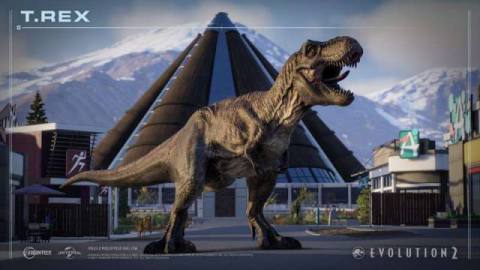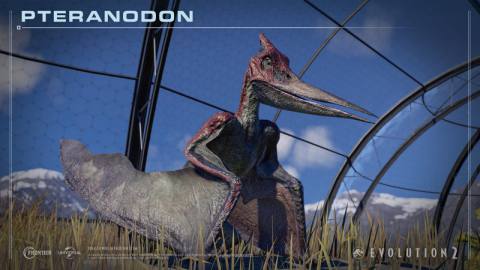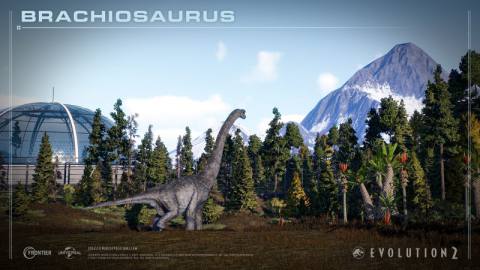
SLIGHT SPOILER: A world of trouble is teased within Jurassic World: Fallen Kingdom‘s final moments. Director Colin Trevorrow shows us what happens next in the little-known short film Battle at Big Rock, which gives the thunder lizards new territory to explore. We’ll have to wait until next June to see how this story concludes in Jurassic World: Dominion, but can soon play through another of this story’s chapters within the video game, Jurassic World Evolution 2.
Frontier Developments says that this sequel will have more of an authentic story that shows us what is happening within the United States. This isn’t just a theme park building experience. You’ll be pushed to contain dinosaur threats in different ways as this narrative unfolds.
In a 30-minute, hands-off demonstration of the game in action, Frontier shows me one of the environments set within the northern hemisphere. Snow-capped mountains stand tall over a sprawling lake flanked by a thick forest of pines. Sunlight dances across the water, leading the eye to another glimmer flickering off of a massive glass dome, which I quickly realize is a new aviary. It’s positioned next to the ominous peak of Jurassic World’s innovation center, which sits next to a crowded street filled with gift shops, attractions, and swarms of people. Behind this commotion, I see movement within the tall pines. The necks of Brachiosaurus bound slowly within them, looking oddly small given just how tall the pines are.
The game’s director Richard Newbold tells me we are looking at a Sandbox map, which stretches across the entire screen. “All of the maps the player has access to are a lot bigger than the first game,” he adds. “There’s a lot more space available to build and place as many dinosaurs as possible. With changes to the territory system, they’re going to need a lot more space in some instances, especially since there’s a direct conflict between some species. It’s not as easy to put as many dinosaurs in the same space. There’s a lot more balance that needs to be done.” Along with the forest theme, the player will make parks in desert settings (which you can see in some of the images).

The dinosaurs that you’ll add to your park and enclosures are more realistic than they were in the first game. Newbold tells me there are over 75 different species to unearth – most are ground dinosaurs, but players can also add marine and flying reptiles as well. In my brief look at this sequel, I wasn’t able to see if the Tyrannosaurs Rex moves in new ways, or if it hunts more realistically, but I did see how it studies its habitat. Newbold hatches two Tyrannosaurs from the Hammond Creation Lab, and to much surprise, they emerge together, looking even more menacing than ever when standing next to each other. Their entry animation is a sight to behold. The Tyrannosaurs’ bodies are brown, but the crowns on their heads appear to be slightly red.
The player will have more skins and colors to choose from when creating their dinos. I’m told each dino has roughly a dozen body colors along with seven different patterns. Holding true to the expeditions from the first game, dino DNA is once again obtained from fossils. When eggs are synthesized, you can tweak the DNA to enhance social behaviors, make them more resilient to disease, less aggressive to rangers, and more. Rather than incubating one egg at a time, you can now generate a clutch of eggs. “As part of this editing phase, you are increasing or decreasing the chance of any of those traits manifesting,” adds Newbold. “Once you make that decision, you choose which ones you want to bring to maturity and release them all in one go as a group.”
When a dinosaur hatches from the Lab, it won’t immediately settle into a state of comfort or agitation, and will instead explore the habitat to see if there’s an area that fits its needs. If that space is found, the dinosaur will claim that territory.
The dinosaurs residing in distinct territories means that the player can set up a variety of areas within the same enclosed space, and hopefully keep them comfortable. When a dinosaur is highlighted in an enclosure, the player will see its territory, which displays as a white outline on the ground.
“This system is dynamic,” says Newbold. “It’s building up as the dinosaurs walk around this enclosure. As the Triceratops moves, it will move its territory in a new direction as the old territory it created long ago starts to decay. It’s walking toward things it needs – water, forest, and ground fiber. It’s not just about that, but also the territory of other dinosaurs in the area. Sometimes the species are complementary and they live together harmoniously; but other times the species will have conflicts. If there’s an overlap in their territories, there may be behaviors between those two dinosaurs. They’ll try to build their territory to their size. It’s a dynamic system that puts a realistic connection between dinosaurs.” This also means a species will rest together, socialize in more ways, and act more like herd in their defined space.
Frontier has made it easier for the player to implement change to these enclosures and has minimized the back and forth between menus and gameplay. Executive producer Adam Woods walks me through this new system. “I can quickly edit the environment with the landscaping tools, and you can see the dinosaur [information] is left up so I can quickly reference it,” he says. “You can see I need forest, so I can use the paint brush tool to add trees. The forest needs are met as I do this.”
Herbivores now feed on the foliage and no longer require feeders, so you’ll need to make sure you add the right plants when editing the terrain. For the Triceratops, the solution is the fibrous ground plant. The number of items that players can add to the enclosure is greatly expanded. I saw roughly a dozen different rocks, and there may have been more.

The enhanced enclosure design extends to the aviary, which can hold numerous flying critters, including the Pteranodon, which I got to see emerge from a Lab. Three of them fly out together, each animated in different ways to give off the impression of a flock. Their habitat is barren at first, but Woods dives into the editing tools to quickly add trees, water, and rocks to it. The size of the aviary is also determined by the player. More glass domes can be added freely – much like the fencing – to make the enclosure grow dynamically. If the Pteranodons grow agitated, they can smash through the glass and fly around the park, potentially going after guests. The player will then need to track them down and tranquilize them to get them back where they belong. I asked if the ground dinosaurs could interact with the flying reptiles, and neither Woods or Newbold wanted to talk about it just yet, saying that answer will come closer to the late 2021 launch of the game.
I didn’t see any dinosaurs fight in my demo, but I’m told the smaller variety will team up to take on larger beasts. Yes, that means raptors hunt in a pack! “Predators, when taking after their prey, will chase after them dynamically,” adds Newbold. “There’s no stopping and starting. There’s improvements to the fighting system as well.”
If a dinosaur is injured, it may need to visit the Paleo-Medical Facility, the one new structure I see among the familiar Ranger Station, Research Center, Park Tour, and more buildings from the first game. This medical facility is white, and has a large fenced-in area behind it where dinosaurs can be treated. You’ll need to fly them in via helicopter. If a dinosaur cannot be treated in the field, you’ll need to bring it here. The example I’m told is if one is seriously injured in battle. The Paleo-Medical Facility also comes with a unique vehicle called the Mobile Vet Unit, which you can freely control (just like all of the other vehicles in the game).
Monitoring dinosaurs’ health will be much easier through the implementation of the new ranger post, which looks to be a small shack that you can place anywhere in an enclosure. The rangers use this station to perform welfare checks. The dino vitals are not as clearly defined in this sequel. Woods says there’s a bit of a “fog of war” to that information, and the player will need to keep tabs on it. The best way to do that is through the ranger post.

Significant enhancements are also being applied to guests, their behaviors, and the structures you can build for them. Each guest’s mood is divided into four categories: adventure, standard, nature, and luxury. They will gravitate to areas that they seek the most. For instance, an adventure junky will want to see carnivores.
The player can tailor attractions and amenities to these specific groups. These two structures are fully customizable, right down to what they offer and how they look. With the click of a button, the base attraction can transform into an aquarium, bowling alley, cinema, arcade, spa, and you name it. The design of that building is also fully customizable. The facade, roof decoration, entrance, entrance location, signage, and immediate surrounding ground can be changed with a number of preset options. For the ground, you can have trees, dinosaur skeletons, flags, and more. The color of all of the items can also be altered. If you want your shop to be hot pink, so be it. If you want each piece to be a different color, you can do that, too. The range of color is extensive, allowing for specific shades to be picked from a wheel.
During my demo, Woods and Newbold were positioned in the lower left, covering up most of the display where the park rating was in the first game. I didn’t get to see what was there, but when Woods moved his arm, I saw a series of arrows. I asked if the player could speed up time, and Newbold responded: “There are some time controls. We allow the player to pause time and also speed up time.” If a problem arises in the park, those time controls may be disabled until that issue is taken care of.
One of the new threats to the northern region is a snowstorm, which covers the ground in snow and can create problems all across the the park, such as losing power.

Woods and Newbold walked me through a number of the game’s new features, but wouldn’t talk about others that were teased in the trailer. We know marine dinos are in this sequel, but I didn’t get to see them. The Mosasaurus lagoon will have to be huge, but what else can we add to it, and how customizable will it be? What other water dinosaurs are in the game? Can they leap up and eat land dinosaurs? We really need to know the answer to that last question…
Details about game modes are also light at this time. I did however learn that the contract missions from the first game aren’t in the story campaign, but will be present in Challenge mode.
Jurassic World Evolution 2 is coming to PlayStation 5, PlayStation 4, Xbox Series X/S, Xbox One, and PC. Frontier says they have nothing to say at this time about a Switch version. Details are also scarce for the new generation versions, but I’m told they will be enhanced.
I walked away from my demo impressed by the changes that Frontier is implementing. It looks to be a much deeper experience than before that gives the player a variety of new toys to use with less hassle. I can’t wait to see that darn Mosasaurus, and how the story will be handled. Here’s hoping they give us looks at these aspects of the game soon!
The Dinosaurs I Saw:
Acrocanthosaurus
Allosaurus
Amargasaurs
Ankylosaurus
Baryonyx
Brachiosaurus
Camarasaurus
Nasutoceratops
Pteranaodon
Stegosaurus
Triceratops
Tyrannosaurus Rex
